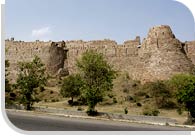Golden Triangle

Humayun's Tomb

Akshardham Temple

Red Fort

Qutub Minar



Depicting the might and grandeur of the Mughal Sultanate, Tughlaqabad city and the fort are known for its typical Indo-Islamic architecture style. Perched on a rocky hill on Qutub-Badarpur Road, Tughlaqabad Fort was built by Ghiyas-ud-Din Tughlaq, the founder of the Tughlaq dynasty in India. To the north of the fort, lies the city of Tughlaqabad.
Background
Located on the outskirts of Delhi, Tughlaqabad Fort was completed in four years, between 1321 to 1324. Ghiyas-ud-Din had selected this site for the fort when he was a mere soldier. This octagonal fort, 8 km from the Qutub complex, was built to provide an imperial and magnificent capital and a defensive structure to the emperor.
Architecture
This grand fort has a border of approximately 6.5 km and covers an area of about 1,902 acres/770 hectares. It is the largest fort in Delhi, and is known for a number of palaces, towers, tanks, mosques and buildings. Even the walls of Tughlaqabad Fort are thicker (35 feet) in comparison to any of the forts in India. The barricade varies from 15 to 30 metres in height from the base. The maximum height including the plinth and the ridge towers upto 60 to 70 metres.
The eastern part of the fort is accessible from the Qutub-Badarpur road. This eastern section is rectangular in shape and surrounded by high walls and bastions. The western side of the Tughlaqabad Fort is wider, with palaces and private rooms. This grand fort also had a reservoir that used to be on the southern side of the fort. A wide anthill on the south eastern-corner of the fort leads to a small fortress, Adilabad. One can also spot a high tower 'Bijai-Mandal' inside the fort. This tower has a long underground passageway which is not open to the public any more.
The fort and Tughlaqabad City, popularly known as the third city of Delhi, it is now mostly in ruins.
 Golden Triangle with Kerala & Mumbai
Golden Triangle with Kerala & Mumbai Golden Triangle with Ranthambore
Golden Triangle with Ranthambore Golden Triangle with Himalayan Monasteries
Golden Triangle with Himalayan Monasteries North India Temple Tour
North India Temple Tour